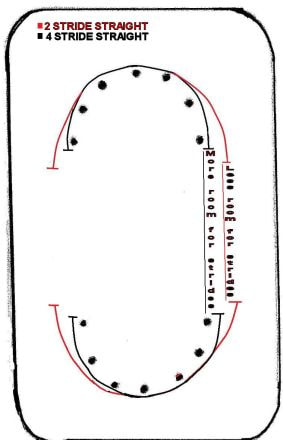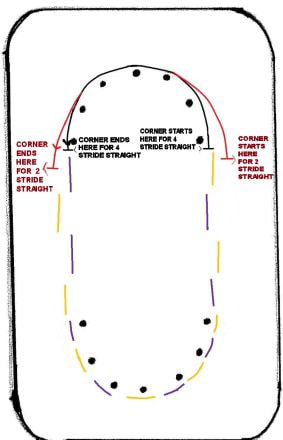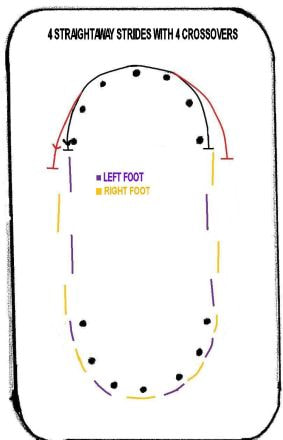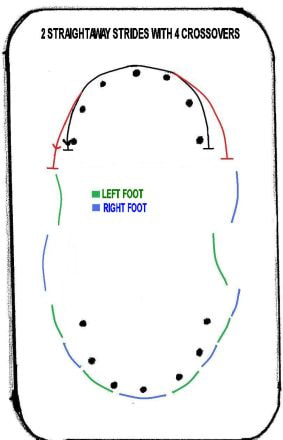Converting from 4 to 2 Strides on StraightBy Susan Ellis, March 2010
|
It's a little like wrestling a gorilla. You don't quit when you're tired, you quit when the gorilla is tired. ~ Robert Strauss |
|
As kids grow and get faster it will be necessary at some point to change from using 4 straightaway strides to just two straightaway strides to allow for better efficiency and power. My philosophy is to get them converted as soon as technique and power allow for efficient full strides. This generally happens sometime around midget (10-12 years). This seems, however to be a difficult transition for many.
One of the main reasons kids find it hard to convert is failure to adjust the entry and exit points. Kids tend to want to keep entering and exiting at the same place as they would on 4 strides when trying to use just 2, making the straights seem long and drawn out and cutting the number of corner strides short. If corner technique is basically decent, then an extra crossover gives far more speed than a straightaway stride. But if they continue to stick with the 4 strides they will start to overshoot the ideal entry point cutting one crossover there, and exit too narrow, cutting another cross there. By entering sooner and a little wider (see diagram to right) they give themselves room for an extra cross in, and by coming off the last two blocks a little they now have room for an extra cross out. |
|
So when do you gauge when to start converting to 2 straightaway strides instead of 4? Look at the entry point for the 4 stride pattern to the left. Typically when a skater starts to overshoot that entry point and go beyond first block with their 4 straightaway strides is when to get them to start switching to 2 straights. At first they may only use the 2 straights in the longer distances where the speed is lower, therefore the tempo is lower, but eventually will grow into using them for all distances including sprints. And they should probably use 4 straights on the first straightaway after the start to build their speed and momentum with more tempo. Even at the elite level many skaters still take 4 straights on the first lap, then change over to 2 for subsequent laps. |
|
To the left is a typical 4 stride straight with 4 crossovers pattern. Notice that the corner entry starts later and narrower and finishes sooner and narrower. To the right is a typical 2 straight, 4 cross track pattern. Notice that the entry starts sooner and wider and finishes later and wider. Notice as well that the stride length is increased as the athlete has typically learned some weight transfer and how to put more pressure in to the ice to ride each blade longer. As the athlete gets even better they might even go to a 3 cross corner on longer distances to conserve more energy. |
|
It’s still a difficult concept for many younger athletes to learn to switch their track. One way is to change the focus point by changing where the blocks are or adding blocks to the track as in the diagram to the right. However, if there are a lot of skaters who are not yet ready to convert this might interfere with their own best stride pattern, so maybe place blocks or cones toward the very outside of the track to indicate entry and exit point. You can even use oversize markers on the ice to draw out the path you want them to take (no worries, the marker comes off with the next Zamboni). Another thing that works very well is to have the athletes count out their stride pattern, ie: 1 cross, 2 cross, 3 cross, 4 cross, 1 straight, 2 straight, or even just count 1-2-3-4-1-2.
One of the biggest fears kids have about using a wider entry or wider exit is that they leave room to be passed by someone. Explain that the reason to enter and exit wider is to give them more speed from the corner and if they have more speed they will be harder to pass anyway. Also explain that they need to sense when a pass is coming and close up their track a bit if they sense that speed alone won’t keep the other skaters behind. One option could be to skate a wider entry in using an extra crossover and then skate a tight exit to prevent an inside pass at the exit. |
For other articles on track patterns check out the following:
Tracks – January 2005
Entry and Exit Width – January 2008
Entry and Exit Trajectory – December 2007
The Extra Crossover – November 2007
Tracks – January 2005
Entry and Exit Width – January 2008
Entry and Exit Trajectory – December 2007
The Extra Crossover – November 2007





